Paradise From Hell
Saturday, August 25, 2007
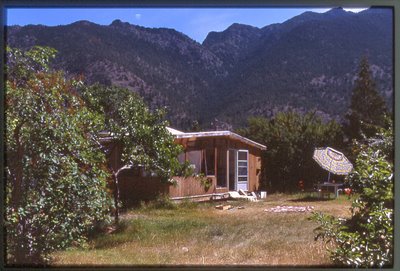 In my life I have either been plagued or blessed (I cannot make up my mind) by female pioneers. All have been members of my family. My maternal grandmother decided that 1954 Buenos Aires was a dangerous place to be and she persuaded my mother that we should move to Mexico. This we did. Then in 1956 my mother was offered to teach in one room school house in Nueva Rosita, Coahuila. It was the school for the children of the employees of the American Smelting & Refining Company. It was a desert with bitterly cold winters and summers from hell. In 1964 my mother moved to teach in Veracruz for the ALCOA Aluminum Company. The summers from hell had the added bonus of "nortes" (how was I to know that these were the tail ends of all those Caribbean tropical storms that are in the news these days?)in which sand would filter into the house and flying cockroaches haunted our bathrooms at night. 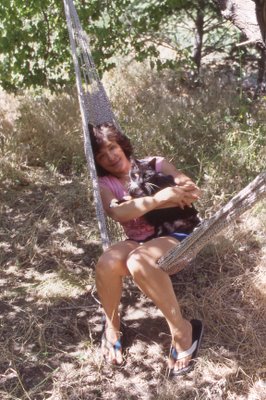 Rosemary, our two daughters and I were living in a cute and solid brick house in Arboledas, outside Mexico City when she told me that she thought things would not prosper for us there and that we should move to Canada. We packed our skyblue VW beetle with our belongings on a roof rack and drove to Vancouver. We had a not so cute and not so solid frame house in Burnaby in 1986. We didn't owe a penny. That's when Rosemary informed me that she wanted a real garden and that we were moving into Vancouver. This we did. 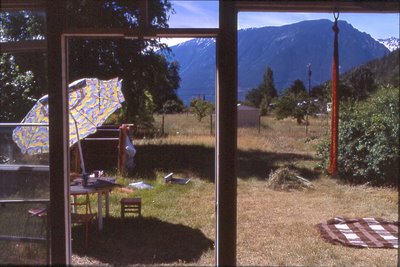 Until recently my daughter Ale lived nearby as did Hilary, Bruce, Rebecca and Lauren. It looked pretty good until Ale bought a property (half acre) in Lillooet and moved in June. She left her teaching job at University Hill Elementary School, lost her seniority status and is currently very happy while facing an uncertain future. Rosemary and I visited Ale on July 1st. We drove in a counter clockwise manner via Hope and then back via Pemberton. There was only one curve between Lilloet and Pemberton. The whole way was one continuous (albeit, breathtakingly beautiful) curve. Ale's house is a fixer upper that has faced several generations of fixer uppers. In the middle of the night (the temperature had diminished to 32degrees) Rosemary told me, "This is a nightmare." Lillooet is very similar to Nueva Rosita. It is a dry desert. The dirt in Ale's back yard is like concrete. But somehow some excellent apple, apricot, peach and pear trees have managed to give abundant fruit and look disease-free. While there is not much that we can do to help Ale in fixing her house I have taken upon myself to bring nicely framed paintings and photographs. Both my mother and I have always believed that framed pictures convert a house into a home. We have bought Ale a solid looking portable propane-fueled Webber. But best of all, to those who may be reading this on Saturday morning, we drove here yesterday with both Rebecca and Lauren. Since Ale only has one bed we brought a tent and sleeping bags. If all went well last night, Ale, Rebecca and Lauren slept in that tent. 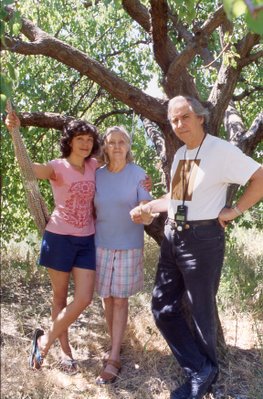 And Rosemary slept well and did not wake me up in the middle of the night to tell me anything.
Three Birthdays, August 17, August 27 & August 31st
Friday, August 24, 2007
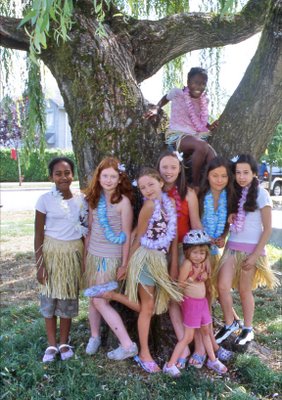
Of my own birthday I have written about here. In brief I hate my own birthdays and I specially hate birthday cakes.
When Rosemary, our daughters Ale (now, 38), Hilary (now, 34) and I lived in Arboledas, in the outskirts of Mexico City in the early 70s, our house was on a block full of children. We were a block away from a long grove of eucalipt trees.
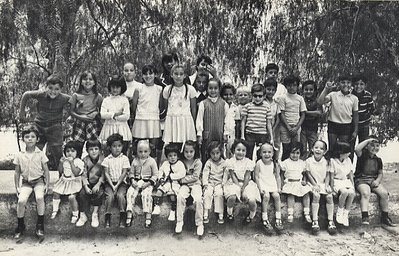
It was there were we celebrated Ale's birthday. In the photo here Ale is on the bottom row, fifth from the right. I took this photograph on August 27, 1972 which was her fourth birthday. Looking back at this picture I am glad Rosemary nagged me to take it.
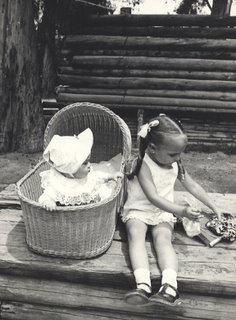
In the other picture you can see Ale opening her presents while her sister Hilary (Rebecca's mother), 8 months old, looked on with primitive envy. I have come to appreciate the value of group photographs of the family and I am glad that someone recorded some of my own birthdays. The picture here was taken in our garden in Buenos Aires on August 31st, 1951. I was nine years old.
I am bottom centre wearing a tie. Behind my right shoulder is my lovely first cousin Elizabeth Blew and behind, making a rare appearance in a photograph is my father George.
For me Rebecca's tenth birthday (August 17), which we celebrated with a Hawaiian themed party on Wednesday, was a bit bittersweet. She is growing up. But it was nice to see that she is still a little girl in some ways. She enjoyed bobbing for apples and, like her Aunt Ale, she also enjoys piñatas. That's because she has never had a Monica in her parties. In my birthday photograph, Monica is the dark girl in front of my father.
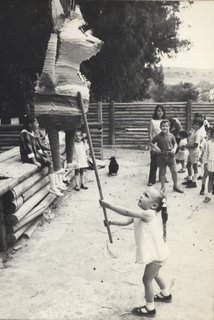
She always broke the piñata, put the tail on the donkey, won the bag races, bobbed the apple in record time and managed to break all my new toys.
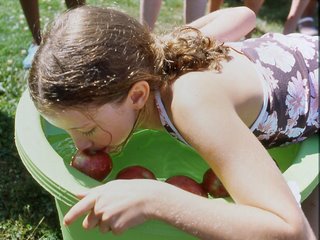
During the birthday party we had curious incident. Rebecca's other grandmother, Marjorie Stewart was making a complaint about our present Mayor Sam Sullivan in relation to the present impasse in the negotiations to settle the civic strike. Rebecca, quite rudely (but with conviction) raised her voice in the direction of her grandmother and said, "You cannot say that about Sam, he is my friend." She then stiffened her spine and left the room to play with her friends.
Recently my first cousin Diane Hayward wrote from Buenos Aires:
I do remember going to one of your birthday parties at the house in Coghlan and enjoying the garden which was full of bushes and trees and seemed like something out of that famous book The Secret Garden - lots of places to hide away and daydream. I was a fanciful child.
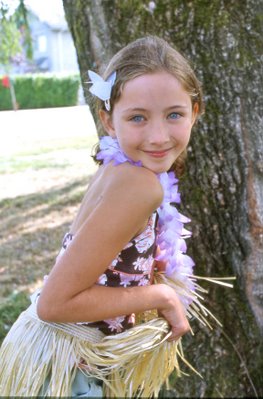
And when I told Sam Sullivan and Lynn Zanatta about Rebecca's altercation with her grandmother she wrote:
Sam wants her on his campaign team.
Betty Crocker, Suki, Derek London & John Fluevog
Thursday, August 23, 2007
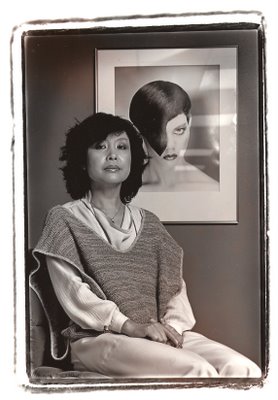
As a little boy I drank Toddy in Buenos Aires. This "fortified" chocolate drink came as a powder that I mixed with milk. The product was advertised as the drink that made Tarzan powerful. When Toddy announced on the weekly Tarzan radio show (naturally Toddy was the sponsor) that it was bringing Tarzan from deepest Africa for an exclusive parade on Avenida de Mayo I asked my mother to take me. My grandmother immediately pointed out that since it was in the middle of a cold August Buenos Aires winter this man could not be the authentic Tarzan as as he could not survive in our cold. I told my grandmother, "Of course he can, he drinks Toddy." And that is how I saw (from far away, there was a large crowd) the authentic and one and only Tarzan.
Rebecca does not quite know if she can believe me when I tell her that some years ago I managed to photograph Betty Crocker when she came to town. She is ambivalent as her mother has told her that Betty Crocker never existed.
I thought the same about three Vancouver persons who were and are an institution. In the late 70s Mac Parry, then editor of Vancouver Magazine told me to go and photograph Suki. At the the time the exclusive salon for women with money was on Robson. I could not believe that Suki actually existed. In the 80s and early 90s I would pass the salon on Seymour called Derek London. I would peer through the window as the female hairdressers of that establishment were unusually beautiful. Sometimes there would be portraits of women at the window that were signed Derek London. I was a bit confused.
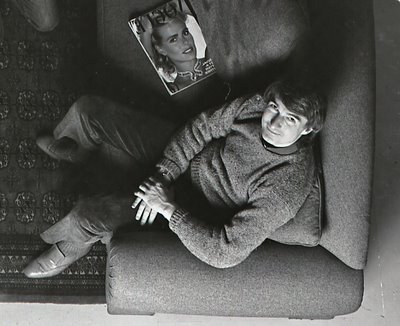
Who was Derek London? And was he also a photographer. I soon found out this was the case as I was told by Vancouver Magazine to photograph Derek London. He was a charmer and we shared an interest in the photography of women. A few years ago Derek London closed his establishment and I would have guessed he moved to some South Sea island to drink gin slings and take pictures of women. That was not the case as London relocated to 1075 Mainland Street (604-684-5905).
It was last year that I took some series of posters advertising "We Shop The Line" for Canada Line. One of them was a person I was convinced did not exist. I had never seen John Fluevog. But whenever I walk on Granville I have always stopped at John Fluvog's shoe store.
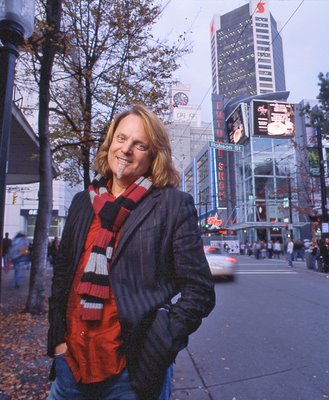
There he was on Granville posing for my photograph. And I would have never imagined him to be over 6 ft tall.
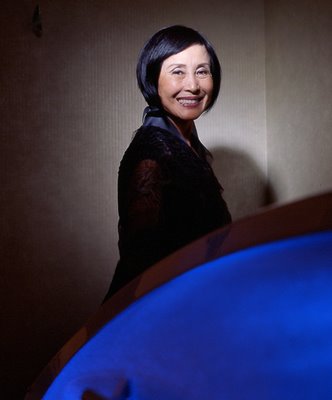
A couple of years ago I got to photograph Suki again. This time it was at her Granville at 16th shop.
While I am now sure that Tarzan does exist I can assure you the Great A&W Root Bear did exist. She is very beautiful and when I last saw her she was driving a white Mercedes in Vancouver. How do I know this? Well you see there was this French Canadian singer called Rene Simard and......But that's another story. Or that living Kerrisdale man who was one of the two designers of our Canadian flag.
Stan Getz, The Toluca Rocket & The Wondrous Latent Image
Wednesday, August 22, 2007
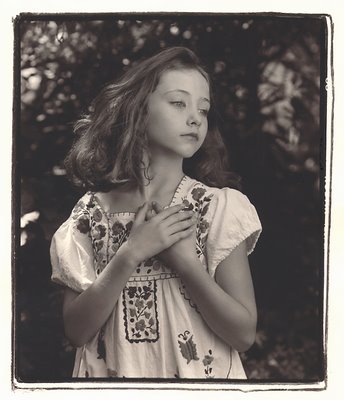
Sometime in 1964 at around 2 in the morning I was with my art major friend Robert Hijar inside the darkroom of the University of the Americas. The university was outside Mexico City on the way to Toluca, the state capital. The darkroom had dusty brick walls that were painted white. We had to keep the print developer trays warm by adding hot developer and water. It was very cold. Every few minutes the room would shake. We would stop using the enlarger until the second class Flecha Roja "Toluca Rocket" the bus with 15-plus forward gears that trecked up from Mexico City to Toluca rumbled by. Robert taught me how to process film and it was with him that I first saw the latent image on a white sheet of photographic paper (Kodabromide F-3) emerge, like magic, in a tray of Dektol.
I never followed all three dictums suggested by American photographer W. Eugene Smith that were his formula for a successful night in a darkroom. He said you needed an interesting negative, good music and booze. I substituted liquor with a good pipe. After a few pipes I would get dizzy with the room's poor ventilation. Robert and I listened to lots of experimental music and lots of Stan Getz. Our favorite was Stan Getz Focus with music composed and arranged by Eddie Sauter. Through all these years I have always had a darkroom. At first it was a bathroom converted to a darkroom. Now I have a darkroom with a bathroom.
Last week's small darkroom flood had me on my knees with a shop wet vac. For days I have had heaters drying the carpet. Finally today I was able to return to my darkroom. I have come to love and appreciate Grant Simmons's fine art giclées of my b+w negatives and slides or the wonderous light jet prints from slides at George King. But there is something to be said still about holding a photograph made from photographic paper or as they call them in the fine art circles "gelatin silver prints".
What you see here is almost as good as holding it. Not quite, because Ilford Multigrade FB Warmtone paper has heft and the image has depth. The reason the print is not b+w is that I immersed it for two minutes in a 1 to 3 bath of Kodak Selenium toner.
I gaze at it. It's on 8x10 paper. It cannot compete with the drama of the 30 by 40 inch giclées (fine art inkjets) that Grant has made for me. But it is the intimacy of being able to hold it and lift it close to the eye. I can almost listen to the Rocket, Stan Getz playing I'm Late, I'm Late and every time that image emerges, as Rebecca's did yesterday afternoon, is feels like that first time.
Not A Musical By Betty Comden & Adolph Green
Tuesday, August 21, 2007
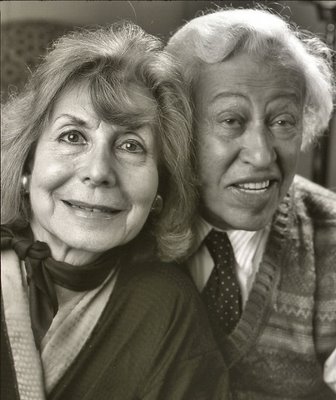 Rosemary arrives tired from work. In recent months I have prepared quick dinners which we sometimes consume (no TV trays, yet) while watching a good film on the Turner Classic Movies Channel. We had never seen Auntie Mame (1958), with Rosalind Russell so we settled down yesterday to enjoy it. But I was quickly unsettled when I noticed the names of Betty Green and Adolph Comden on the initial credits. I wasn't prepared for a musical. We Latin Americans (or at the very least this one) can become Americanized and Canadianized to a certain point but we like our theatre as theatre and our opera as opera. We sometimes make fun of the Spaniards with their zarzuelas (Spanish operettas). The idea of a romantic couple talking to each other and then suddenly one of them begins to sing is mostly alien to me. Mexicans made films in the 40s and 50s with the likes of actor/singers Pedro Infante and Jorge Negrete in ranchero outfits and hats. They had bloodless duels (their sidearms were mostly for decoration) as they insulted or one-upped each other with extemporaneous song. Sort of like dueling banjos (but with guitars) by the cantina. I liked them. I even saw one, Gran Casino (1947) with Jorge Negrete which was directed, by Luis Buñuel, no less. I have become more tolerant of musicals of late but I cannot stand the tap dance, top hat and cane (or umbrella ) routine not even if it involves Fred Astaire or Gene Kelly. I think I would go as far as saying I hate tap dance in any form. So Auntie Mame took me by surprise when it became evident that nobody in the movie was going to suddently burst into song. It was then that I realized I had not read the credits correctly and Green and Comden had written the screenplays! I smiled and remembered when I had knocked on their door, some years ago, at the Vancouver Hotel. John Lekich had interviewed them (perhaps the early 90s) but the publicist had not warned them of my arrival. They were a bit nonplussed but they did pose for me as you can see here. Before Auntie Mame began we saw the tail end of Gene Kelly's 1957 Invitation to the Dance. I had never seen this film. As a young boy or a young man I would have hated it. But my interest in ballet in the 90s introduced me to ballerinas like Evelyn Hart who not only can dance but can also act. This prepared me to thoroughly enjoy this wordless musical (now that's a concept that I can understand). I will have to see it in its entirety for another reason. In a few minutes I nailed down the familiar-sounding(extremely cool) jazz pianist who was also in charge of the musical direction. I can safely say that my favourite jazz pianist of all time was and is Andre Previn.
Rebecca In Blue
Monday, August 20, 2007
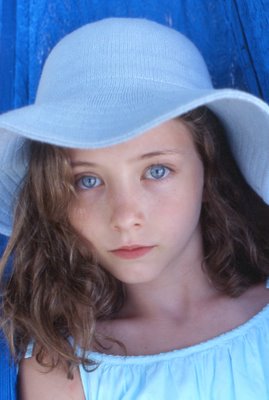 My memories of my house in Melian in Buenos Aires are cloudy. Of our dining room I remember that we had Thomas Gainsborough's Blue Boy and another which I swear my mother called Mistress Willoughby which showed a young girl wearing either a sun bonnet or holding a parasol. 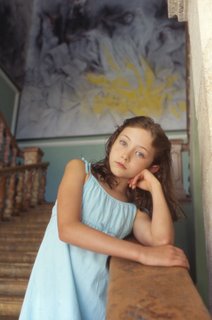 I will never forget our pink floral paper drapes. My mother had obtained them from an American friend. During the war cotton and most cloth was deemed necessary for the war effort so Americans bought these paper drapes. 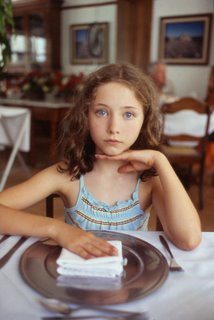 My memory of all this centers around the year 1949 when I was 7. I loved that Blue Boy and I was not aware until many years later of the cliché it was. 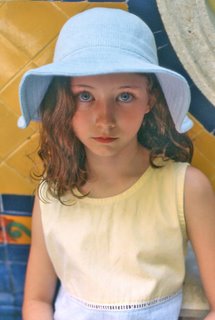 In recent times I would assert that Gainsborough's Blue Boy has been replaced by da Vinci's La Gioconda as the cliché image to be found decorating waste paper baskets. 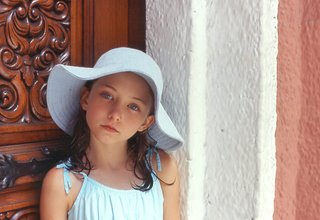 While I have never asked Rebecca what her favourite colour is I would guess that blue must be the one as in most of my portraits of her (these were all taken in Mérida, Yucatan) there is always some blue. 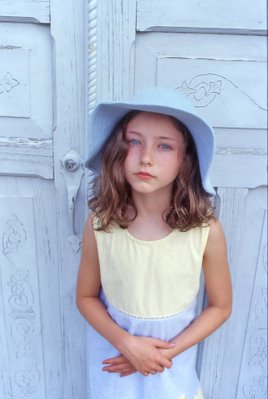 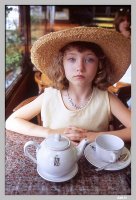 And here is that first picture of Rebecca in her yellow and blue Uruguayan dress. We had just purchased it when we stumbled into a Punta del Este tea house and took this picture that started this series of Rebecca staring at the camera with no hint (almost always) of a smile. This is Rebecca three years ago. The usual combination for this one and most of the above is a Nikon FM-2, an F-2 35mm wide angle and Kodak Ektchrome 100G. Because of the low light of most restaurants I usually shoot wide open at 1/60 or 1/30 sec.
Asymptotes & Rebecca Grows Up -No!
Sunday, August 19, 2007
You find it hard to forgive those who, early in life, have come to enjoy the advantages which go with maturity. Aside from any other consideration, why don't you put into the balance the long spring enjoyed by a youth who matured late.
Markings -Dag Hammarskjöld

When Rosemary and I travel with Rebecca we glory at the fact that she is a little girl. She has tantrums ( berrinches). She cries. But then she asks questions that surprise and sometimes trouble us. When she misbehaves, by forgetting her camera or some article of clothing in a restaurant, I find myself telling her (and I should know better) that she has to be more responsible. When I do this I remember the above quote.
Rebecca and I have a favourite game, quite painful in Mexico with the ubiquity of old VW beetles. When one passes by, the first person to say, "White (depending on its colour) punchbuggyy, no returns," has the right to punch the other person. We punched each other with gusto when we rode the buses or the calesa (horse-driven carriage) in Mérida.
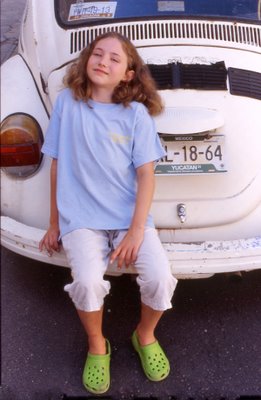
Would it not be nice if she were never to grow up? I think of Oskar Matzerath from Günter Grass' The Tin Drum. But, alas, Rebecca was 10 on Friday.
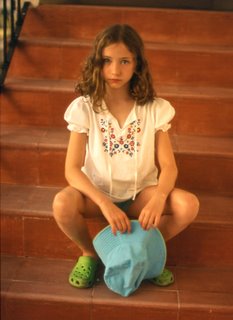
Besides my memory of Rebecca as a child I have my photographs of her that record this inevitable transition. It reminds me of our ploy to waste time in Brother Edwin Reggio's (seen here with Rebecca during our recent trip to Austin, Texas) religion class so many years ago. We would ask him if stealing a thousand dollars was a mortal sin. He was affirmative to this.
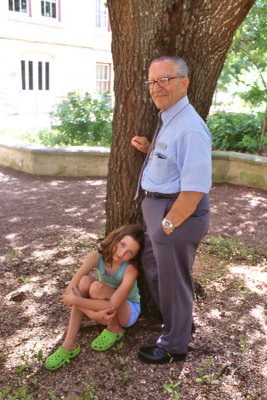
Then we asked him if stealing one cent was a mortal sin. He told us it was a venial sin. Then we would go up from one cent to one dollar and go down, slowly from one thousand to one hundred. We had not yet been taught the concept of the asymptote (the calculus and limits were some years away). We wanted to know at what point, in dollars and cents, a venial sin was transformed into a mortal one.
Photographers in the 19th century were obsessed with the idea of pointing their camera at a dying person's face to try to capture that moment between life and death, that moment when the soul goes from here to there.
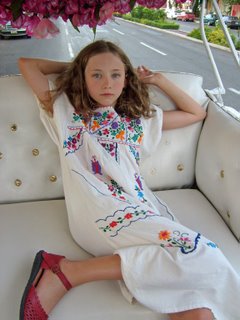
I look at my photographs of Rebecca in the same way. In which one is she no longer the child?
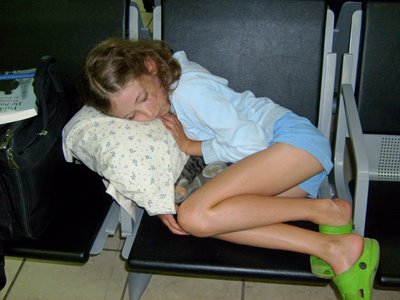
|





































